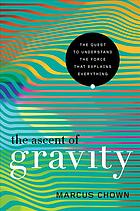
The Ascent of Gravity
The Quest to Understand the Force that Explains Everything
- اطلاعات
- نقد و بررسی
- دیدگاه کاربران
نقد و بررسی

September 11, 2017
Science writer and former Caltech astronomer Chown (What a Wonderful World) details nature’s most familiar force in this sleek, well-paced account of gravity. Meticulously organized and researched, the book is split into three epochs: Newtonian, Einsteinian, and quantum. Chown opines on moments in the lives of Newton, Einstein, and others through the use of historical records and assorted quotations. He describes how “Newton alone created a system of the world, which united the Earth and the heavens in one theoretical framework.” In Newton’s system, gravity is an “invisible string that holds onto the planets and stops them flying off to the stars.” Centuries later, Einstein redefined gravity as warped space-time—Newtonian physics was wrong, but remained, in Chown’s words, “a fantastically good description of the everyday world.” Quantum mechanics, beautifully clarified in Chown’s dexterous prose, shows that nature on the smallest scale is noncontinuous: “Grainy, like a newspaper photograph inspected close up.” Newtonian and quantum theories describe the universe in all but extreme scenarios, yet are a “severe straitjacket” on any unified-theory candidate, such as superstring theory. Chown explains how energy demands have stymied further experimentation on the standard model, but readers will be curious and excited about future theories that may prove to be “as stupendous as they are unguessable.”

September 15, 2017
A fresh look at gravity and how "we are on the verge of a seismic shift in our view of reality, one more far-reaching in its consequences than any that has gone before."Gravity's strength is minuscule, yet it dominates the universe. Science writers have not ignored the subject, but the world-shaking 2015 discovery of gravitational waves is provoking a flurry of updates. New Scientist cosmology consultant Chown (What a Wonderful World: One Man's Attempt to Explain the Big Stuff, 2013, etc.) is early out of the gate, and readers searching for a lucid popular account would do well to start here. The author begins with Isaac Newton, who showed that gravity was a universal phenomenon whose actions could be calculated by anyone. However, he could not explain how it worked, and no one (Newton included) felt comfortable with one body influencing another magically across empty space. Einstein's theory of relativity eliminated magic by explaining that any mass warps space-time in its vicinity. Following Newton's laws, all bodies move in a straight line. They appear to bend when passing through warped space-time, but they are still following the straightest path. "Because that theory recognizes that gravity is nothing more than the curvature of space-time," writes Chown, "the quest to understand gravity has been transformed into a quest to understand the origin of space and time." Relativity theory predicts gravitational waves, but they are incredibly feeble. Einstein doubted humans could detect one, but success would reveal so much new knowledge that physicists could not resist trying. The author spends less time on the mechanics of gravity wave detection than the implications, concluding with discussions of string theory, quantum mechanics, black holes, dark matter, and the ongoing search for a deeper theory. This is de rigueur for popular books on cosmology, but Chown's effort is more comprehensible than most. A fine report on the latest piece of the puzzle that may, sooner or later, enable physicists to explain everything.
COPYRIGHT(2017) Kirkus Reviews, ALL RIGHTS RESERVED.

October 1, 2017
The recent discovery of gravitational waves by the LIGO Lab, a collaboration between Caltech and MIT, motivated astronomer Chown (The Magic Furnace) to write this latest book. The text is divided into three parts (Newton, Einstein, and Beyond Einstein) and features whimsical chapter titles such as "Beware the Tides of March" and "Catch Me If You Can." Each part is roughly chronological, though the author covers many eras within in each section. In doing so, he reveals viewpoints that may be new to nonscientists such as "gravity is acceleration." He also intersperses profundities with humorous references to works such as Douglas Adams's The Hitchhiker's Guide to the Galaxy. Chown discusses Galileo, Isaac Newton, Albert Einstein, and scientists or astronomers in their historical context. By also exploring their personal lives, the author enhances his discussion of their breakthroughs in understanding gravity. The result is a readable, up-to-date discussion of gravity--one of the weakest but most obvious forces we experience, a force that is less distinct in the newer quantum view of the universe. VERDICT Adults and teens interested in science history and exciting new physics and astronomy discoveries will thoroughly enjoy.--Sara R. Tompson, Jet Propulsion Laboratory Lib., Archives & Records Section, Pasadena, CA
Copyright 2017 Library Journal, LLC Used with permission.




دیدگاه کاربران